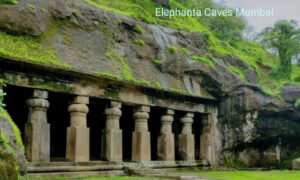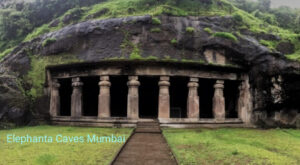Nestled on Elephanta Island, just off the coast of Mumbai, the Elephanta Caves Mumbai, stand as a testament to India’s rich cultural and religious heritage. This UNESCO World Heritage Site is not only a marvel of ancient rock-cut architecture but also a sacred space that captures the essence of Hindu mythology. With its intricate carvings and awe-inspiring sculptures, the Elephanta Caves attract thousands of visitors each year who come to witness the grandeur of this historical monument. This blog delves into the history, architecture, and significance of the Elephanta Caves, offering a comprehensive guide for anyone planning to explore this iconic site.

1. Elephanta Caves Mumbai: Historical Background
The Elephanta Caves are believed to have been constructed between the 5th and 8th centuries, during the reign of the Rashtrakuta dynasty. Although the exact origins remain somewhat obscure, historians suggest that the caves were primarily used as a place of worship dedicated to Lord Shiva, one of the principal deities in Hinduism. The name “Elephanta” was given by Portuguese explorers who, upon discovering the island, were struck by a large stone elephant statue that once stood near the entrance of the island. This statue now resides in Mumbai’s Jijamata Udyan (formerly Victoria Gardens).
The caves are a remarkable example of the religious and cultural practices of the time, reflecting the influence of Shaivism in the region. The main cave, also known as the Great Cave, is particularly significant as it houses several large reliefs and sculptures depicting various aspects of Lord Shiva, including his iconic Trimurti form.
2.Elephanta Caves Mumbai: Architectural Marve
The Elephanta Caves are a splendid example of rock-cut architecture, a technique that involves carving out entire structures from a single rock. The caves are arranged in a series of chambers, with the main cave (Cave 1) being the most prominent. This cave is 39 meters deep and houses several intricately carved sculptures that have been meticulously chiseled into the stone.
3.Sculptural Highlights
One of the most striking features of the Elephanta Caves is the 6 meter high Trimurti sculpture, which is considered the masterpiece of Elephanta. This sculpture depicts the three-faced aspect of Lord Shiva, representing creation, preservation, and destruction. Each face of the Trimurti has a distinct expression, symbolizing the various roles of the deity in the cosmic cycle.
Another notable sculpture is that of Ardhanarishvara, which depicts Lord Shiva as half-man and half-woman, symbolizing the unity of masculine and feminine energies. The relief of Ravana shaking Mount Kailash is another intricate work, capturing the might of the demon king as he attempts to uproot the abode of Shiva.
4.Artistic Style and Techniques
The art in Elephanta Caves is characterized by its attention to detail and the fluidity of the figures, which convey a sense of movement and life. The sculptures are carved in a style that reflects the Gupta tradition, known for its elegance and grace. The complexity of the carvings, combined with the monumental scale, showcases the advanced skills of the artisans who created these masterpieces. The caves also feature several smaller shrines and a number of other sculptures that add to the spiritual ambiance of the site.
• The Island and Its Attractions
Elephanta Island itself is a beautiful and serene location, offering a respite from the hustle and bustle of Mumbai. The island is covered in lush greenery and provides stunning views of the surrounding waters. A walk around the island reveals several other attractions, including Cannon Hill, which offers panoramic views of the Mumbai skyline, and a Buddhist stupa, further adding to the island’s historical significance.

5.Visiting Elephanta Caves
• How to Reach
Reaching Elephanta Caves is an adventure in itself. The island is accessible by a ferry ride from the Gateway of India, located in South Mumbai. The ferry ride takes about an hour and offers scenic views of the Mumbai harbor. Once you arrive at the island, a short walk or a toy train ride will take you to the base of the hill, where the caves are located.
• Best Time to Visit
The best time to visit Elephanta Caves is during the cooler months, from November to February. The weather during this period is pleasant, making it ideal for exploring the island and its caves. The monsoon season, from June to September, should be avoided as the ferry services can be disrupted due to rough seas.
•Visitor Tips
– Tickets: Visitors are required to purchase tickets for both the ferry ride and entry to the caves. It’s advisable to buy tickets early, especially on weekends, to avoid long queues.
– Timings: The caves are open from 9:00 AM to 5:30 PM. It’s best to start early in the day to explore the site fully.
– Things to Carry: Comfortable walking shoes, water, and sunscreen are recommended. Be prepared for some uphill walking, especially if you choose to skip the toy train.
– Local Vendors: There are several local vendors selling souvenirs, snacks, and drinks. However, it’s a good idea to carry your own snacks if you prefer.
6.Preservation and Challenges
The Elephanta Caves have faced several challenges over the years, including natural wear and tear, environmental factors, and the impact of tourism. Efforts to preserve the caves have been ongoing, with initiatives aimed at protecting the sculptures from further damage and maintaining the site for future generations. The Archaeological Survey of India (ASI) has been actively involved in the conservation efforts, ensuring that this historical monument continues to inspire awe in visitors.
However, the increasing number of tourists poses a significant challenge to the preservation of the site. Sustainable tourism practices are essential to minimize the impact on the delicate structures and ensure that the caves remain intact for years to come.
Conclusion:
The Elephanta Caves are more than just a tourist destination; they are a gateway to India’s ancient past, offering a glimpse into the country’s rich cultural and religious history. The intricate carvings, the serene island setting, and the spiritual ambiance make it a must-visit for anyone interested in history, art, and architecture. As you walk through the ancient halls of the Elephanta Caves, you are not just witnessing art—you are experiencing a legacy that has stood the test of time. If you find yourself in Mumbai, make sure to set aside a day to explore this extraordinary site and immerse yourself in its timeless beauty.
FAQ:
1.What is the entry fee for Elephanta Caves?
2.Is Elephanta Caves worth a visit?
3.What is the best time to visit Elephanta Caves?
4.Elephanta Caves ferry
5.10 Lines about Elephanta Caves
6.Elephanta Caves photos
7.Elephanta Caves located in which state
8.How to reach elephanta caves mumbai
9.Elephanta caves mumbai opening time

